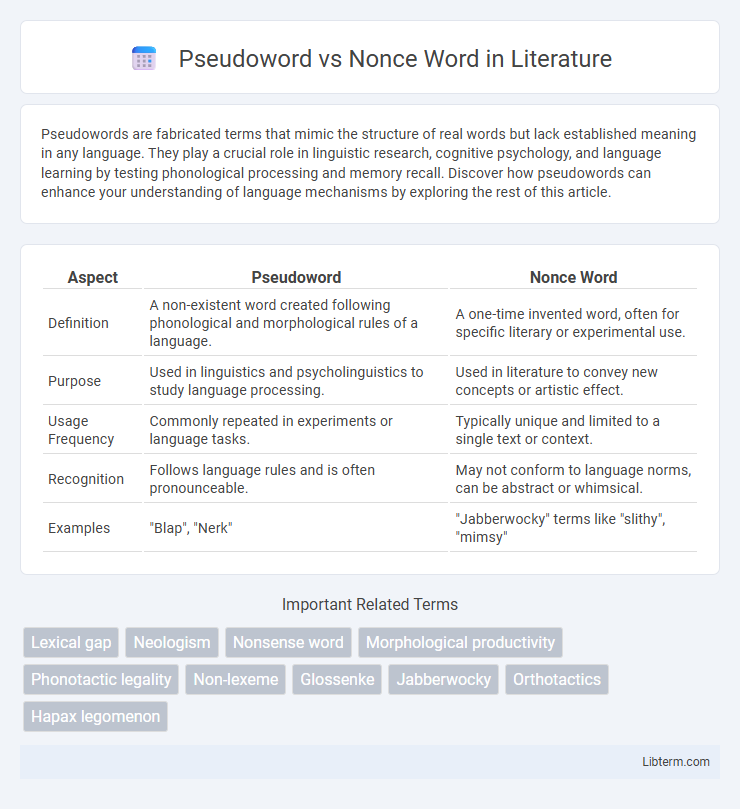Pseudowords are fabricated terms that mimic the structure of real words but lack established meaning in any language. They play a crucial role in linguistic research, cognitive psychology, and language learning by testing phonological processing and memory recall. Discover how pseudowords can enhance your understanding of language mechanisms by exploring the rest of this article.
Table of Comparison
| Aspect | Pseudoword | Nonce Word |
|---|---|---|
| Definition | A non-existent word created following phonological and morphological rules of a language. | A one-time invented word, often for specific literary or experimental use. |
| Purpose | Used in linguistics and psycholinguistics to study language processing. | Used in literature to convey new concepts or artistic effect. |
| Usage Frequency | Commonly repeated in experiments or language tasks. | Typically unique and limited to a single text or context. |
| Recognition | Follows language rules and is often pronounceable. | May not conform to language norms, can be abstract or whimsical. |
| Examples | "Blap", "Nerk" | "Jabberwocky" terms like "slithy", "mimsy" |
Introduction to Pseudowords and Nonce Words
Pseudowords are phonotactically plausible letter strings or sounds that conform to the rules of a given language but lack meaning, often used in linguistic experiments to study word recognition and processing. Nonce words, created for a single occasion, serve as temporary linguistic inventions to test language comprehension or creativity without entering the lexicon. Both pseudowords and nonce words enable researchers to explore cognitive mechanisms behind reading, phonological awareness, and lexical access by isolating form from meaning.
Defining Pseudowords: Meaning and Usage
Pseudowords are letter strings or sound combinations that follow the phonotactic rules of a language but do not have any assigned meaning in the lexicon, making them ideal for psycholinguistic experiments and reading research. Unlike nonce words, which are newly coined terms often created for a specific context or purpose and may acquire meaning over time, pseudowords are strictly meaningless and designed to test processes like phonological decoding without semantic interference. Their usage is prevalent in cognitive assessments and language acquisition studies to evaluate how individuals process novel linguistic stimuli that mimic real words in structure but lack semantic content.
What Are Nonce Words?
Nonce words are invented terms created for a specific occasion or context, often to fulfill an immediate need in communication or literature. Unlike pseudowords, which resemble real words but lack meaning and are used primarily in linguistic research, nonce words carry unique or playful meanings crafted by the speaker or author. These words may later enter common usage if widely adopted, highlighting their potential to evolve language dynamically.
Historical Overview of Both Terms
The distinction between pseudowords and nonce words dates back to early 20th-century linguistic research, where pseudowords were defined as constructed letter strings that conform to phonotactic rules but lack meaning, primarily used in psycholinguistic experiments. Nonce words originated in the 19th century, introduced by lexicographers like Samuel Johnson to describe words coined and used once for a specific occasion or context. Both terms evolved through structuralist and generative linguistic frameworks, with pseudowords becoming instrumental in studies of reading and language processing, while nonce words contributed to understanding language innovation and lexical creativity.
Key Differences: Pseudowords vs. Nonce Words
Pseudowords are constructed strings that resemble real words but have no meaning, often used in linguistic experiments to study phonological processing and decoding skills. Nonce words, created for a specific occasion or experiment, may carry temporary meaning or context within that instance but are not established in the language lexicon. The key difference lies in pseudowords' strict focus on phonotactic plausibility without semantic content, whereas nonce words can have situational relevance and assigned meaning for the purpose of testing language use or creativity.
Linguistic Functions in Language Studies
Pseudowords serve as controlled, phonotactically plausible stimuli in psycholinguistic experiments to investigate language processing and lexical access without semantic interference. Nonce words are coined for specific communicative contexts to analyze morphological productivity and syntactic integration within natural language use. Both constructs facilitate the study of linguistic functions by isolating phonological, morphological, and syntactic variables in experimental and theoretical linguistics.
Examples of Pseudowords and Nonce Words
Pseudowords such as "blark" or "smeeb" are constructed to resemble real words but have no meaning, often used in linguistic and cognitive research to test phonological processing. Nonce words like "flibble" or "snarp" are created spontaneously for a specific occasion or purpose, sometimes gaining temporary meaning in literary or conversational contexts. Both pseudowords and nonce words share phonotactic plausibility, but nonce words often serve a function in storytelling or creative language use.
Role in Psycholinguistics and Cognitive Research
Pseudowords such as "blit" or "trusk" are non-lexical items designed to follow phonotactic rules, enabling researchers to study phonological processing without semantic interference in psycholinguistics. Nonce words, often created for one-time experimental use, allow cognitive researchers to investigate lexical acquisition, morphological parsing, and memory encoding under novel linguistic conditions. Both constructs serve critical roles in dissecting language comprehension, production, and learning mechanisms within the human brain.
Applications in Literature and Creative Writing
Pseudowords serve as non-meaningful, phonotactically plausible constructs used in literature and creative writing to explore language processing and reader engagement without semantic interference. Nonce words, created for a single context, enrich narratives by injecting originality and emphasizing thematic elements, as seen in works by Lewis Carroll and James Joyce. Both tools expand linguistic creativity, foster reader curiosity, and aid character development through unique lexical innovation.
Conclusion: Importance in Linguistic Analysis
Pseudowords and nonce words play a crucial role in linguistic analysis by providing controlled stimuli to study language processing, acquisition, and cognitive mechanisms without semantic interference. Their use aids in isolating phonological and morphological effects, enabling researchers to investigate language patterns and mental lexicon organization. Understanding the differences and applications of pseudowords and nonce words enhances the accuracy of psycholinguistic experiments and contributes to advancements in language theory and education.
Pseudoword Infographic

 libterm.com
libterm.com